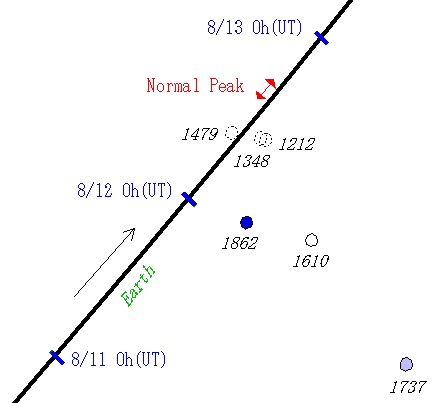
109P/Swift-Tuttle is parent comet of Perseids.
I calculated distributions of trails of 109P in 2005.
| Ejection Year | Date(UT) | Time | Sol.Long. (2000) | delta-r (AU) | Ejection velocity (m/s) | delta-a (AU) | fM | R.P. | V(km/s) | Notice. | |
| Alp. | Del. | ||||||||||
| 1862 | Aug.12.10 | 02:18 | 139.414 | +0.0048 | +23.09 | 1.583 | 1.0 | 45.95 | +57.73 | 59.32 | so far |
| 1737 | Aug.12.08 | 01:56 | 139.400 | +0.022 | +20.63 | 1.326 | 0.52 | 46.16 | +57.38 | 59.08 | so far |
| 1610 | Aug.12.23 | 05:35 | 139.546 | +0.0098 | +11.70 | 0.758 | 0.035 | 45.92 | +57.51 | 59.31 | so far |
| 1479 | Aug.12.37 | 08:58 | 139.681 | -0.00087 | +4.88 | 0.322 | 0.0062 | 45.87 | +57.67 | 59.49 | small fM |
| 1348 | Aug.12.45 | 10:46 | 139.753 | +0.0013 | +2.22 | 0.147 | 0.0022 | 45.92 | +57.71 | 59.43 | small fM |
| 1212 | Aug.12.46 | 11:00 | 139.762 | +0.0017 | +1.15 | 0.078 | 0.00095 | 45.89 | +57.72 | 59.41 | small fM |

In this year, trails of a good condition do not exist.
New trails (1862, 1737 and 1610) are far from the earth orbit.
The trail of 1479 is very near as -0.00087 AU. But the value of fM is very small as 0.0062 because of the perturbation of Jupiter in 1872. This part of trail is very extended and a density of dust is very thin. So the peak is not observable level. Older trails (1348 and 1212) are also the same as the trail of 1479.
In 2004, the trail of 1862 gave a sharp peak. But in 2005, the peaks of trails will be not observal. We should pay attention to "normal peak" (Sol.long. : about 140.0).